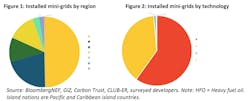Minigrids can serve about half the people in the world — about 111 million households — who lack electricity by 2030 at a cost of $128 billion, although increased policy support is needed, according to a report.
There are about 5,500 minigrids in Sub-Saharan Africa, Asia and small island nations, with some in Latin America, according to State of the Global Mini-Grids Market Report 2020, released July 1 by the MiniGrid Partnership.
“More than ever, we need a thriving minigrids sector that can power critical infrastructure and give access to the 789 million people worldwide who lack electricity,” said Damilola Ogunbiyi, CEO of Sustainable Energy for All, which published the report with BloombergNEF, a consulting firm.
Solar hybrid minigrids provide power at a leveled cost of 49 cents/kWh to 68/kWh, making them the least expensive option for electricity in many areas that lack power, according to the report.
“Minigrids are the most suitable option for many low- and medium-density areas and can address a larger number of low-income families more economically than the alternative options,” the report said.
The report didn’t include minigrids that are based on fossil-fueled or hydroelectric generation.
Grid vs minigrids
So far, expanding access to electricity has mainly been done by extending the grid. However, the report found there are fewer areas where it makes economic sense to extend the grid.
“It is critical for governments and utilities to take a least-cost approach that takes advantage of the breadth of technology options, particularly given that many state-owned utilities are debt ridden and the need for electricity access urgent,” the report said.
Solar-hybrid minigrids make up about half of all minigrids, but they are the fastest growing segment among minigrid options, according to the report.
The report found installing photovoltaic modules in minigrids generally improves their economics compared to only using diesel generators. Also, adding day-time demand to match the solar output can cut a minigrid’s overall cost of electricity, the report said.
Most minigrid developers are small-scale companies or startups, but major companies like EDF, Enel, ENGIE, Iberdrola, Shell and Tokyo Electric are jumping into the market, partly to support sustainable development goals, the report said.
Minigrid developers face two main challenges.
First, rural customers often have limited power demand and sometimes lack the ability to pay. In response, some developers are targeting small businesses and industrial users along with residential consumers to increase per-customer revenue, the report said.
Second, there are few policies and regulations supporting minigrids, which currently largely rely on public financing. “A small number of countries are setting up clear frameworks designed to expand the minigrid market, and are attracting private sector interest,” the report said.
The way forward
The report urged governments to take initiatives and promote robust regulatory frameworks that support minigrid development, especially by offering “results-based financing,” which pays developers when specific targets are met.
Minigrid developers can improve the economics of their projects by cutting operating expenses and looking for ways to increase electricity demand, according to the report.
Using a pay-as-you-go model, developers should consider offering customers electric appliances that will improve their lives, the report said.
“Provision of appliances increases demand and can encourage small enterprise, leading to more predictable loads, greater economic growth in rural areas and lower storage costs,” the report said.
The report found that 14 funders belonging to the Mini-Grids Funders Group had approved $2.1 billion in project funding, but only 13% of it had been disbursed.
“This suggests that there can be significant delays in getting funding, and therefore in projects moving forward,” the report said. “There is also a lack of pure commercial financing as the minigrid market lacks scale and developers’ project track records are limited.”
Track news about minigrids. Subscribe to the free Microgrid Knowledge newsletter.







